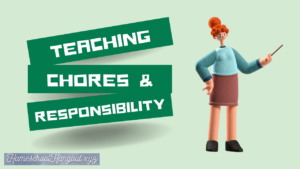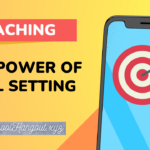I answer the most common question I ever get, “Is it easy to homeschool?” It is a complicated question and depends on what aspect you are talking about. I also address some criticism I have recently received and possibly ranted just a bit.

I answer the most common question I ever get, “Is it easy to homeschool?” It is a complicated question and depends on what aspect you are talking about. I also address some criticism I have recently received and possibly ranted just a bit.

As a parent, one of our long-term goals is to see our children become self-sufficient. I would love to achieve this by the time they reach high school, so they can test out their adult skills before fully embarking on adulthood. But how do we bridge the gap between a toddler and a responsible young person? It’s not an overnight process, but with consistent guidance and structure, we can help them grow.
Here are some effective steps you can take:
Identify Age-Appropriate Chores: Start by selecting three chores or responsibilities that are suitable for your child’s age and abilities. These tasks should be manageable but still contribute to the overall well-being of the family. They can be anything that is age-appropriate, no matter how small. It can start with something as simple as folding washcloths for preschoolers.
Implement a Reward System: Introduce a reward system to motivate your child. The reward doesn’t necessarily have to be monetary; it could be a special privilege, a trip to the movies, or something they have been wanting. Here is a structured approach to the reward system:
Determine a specific time frame, such as one month.
Choose a reward that your child will find motivating.
Decide on the number of required positive actions (e.g., completing chores without being reminded).
Visual Aids for Progress: Create a daily chart to help your child track their progress. You can find many templates online, or even get creative and make one together. Visual aids like charts can help children understand their progress and stay motivated.
Set Clear Expectations: Demonstrate each chore exactly how you expect it to be done. Be thorough in your instructions and provide feedback as needed.
Consistency is Key: After implementing the new chores and reward system, stick to it for at least a month. This allows children to understand the expectations and helps to establish a new routine.
Gradual Increase in Responsibility: Once the initial three chores become a part of your child’s routine, it’s time to up the ante. Add three new chores and continue the process of growth and reward.
By following these steps, you can help your child develop a sense of responsibility and pride in their accomplishments. Moreover, as they learn to take on tasks, the load on you will lighten, creating a more balanced and harmonious home environment.

Let’s face it; goals are not magically met, and plans don’t just happen. We, as parents and educators, need to guide our children in learning how to set objectives and work towards them systematically. This skill is invaluable not only during the summer but throughout their entire lives. It might even save them years of frustration and help them achieve things they never thought possible.
Step 1: Identifying the Goal
Let’s start with an example. Imagine your child has a goal of learning to swim. This is a common summer aspiration, but it’s not something that can be achieved overnight. Start by helping your child identify this specific goal.
Sit down with your child and have them express their interest in learning to swim. Discuss the reasons behind this goal and why they want to achieve it. This step is crucial because it helps the child understand their motivation and commitment to the task.
Step 2: Outline the Goal
Once the goal is identified, the next step is to outline it clearly. Let’s take swimming as an example. The outline could look something like this:
Learning basic water safety skills: This includes getting comfortable in the water, blowing bubbles, and learning how to float.
Mastering the kicking motion: Learning how to kick properly while submerged.
Developing arm movements: Practicing different arm strokes and coordinating them with breathing.
Step 3: Breaking Down the Steps
After outlining the goal, it’s essential to break it down into smaller, manageable steps. This is where the real magic happens. Teaching your child to identify and break down the steps they need to take will help them understand the process better and build confidence in their ability to achieve their goal.
For learning to swim, each of the outlined steps could be further broken down into daily or weekly tasks. For example, practicing blowing bubbles for 10 minutes a day, or doing kicking exercises for a set number of repetitions.
Conclusion
By guiding your children through this process, you’re not only helping them achieve their summer goals but also teaching them valuable life skills. The skills of goal-setting, breaking down tasks, and managing progress are essential for success in all areas of life. So, this summer, let’s not just watch our children’s dreams float away, but help them learn to swim towards those dreams and make them a reality.
Remember, the process may take time and effort, but the sense of accomplishment they will feel is truly priceless.

“I don’t know what to play with.” Admit it, you have heard that from your kids. I think it drives every parent crazy, but especially here in the United States where we know that our kids have and do so much! An “I’m bored” in my house is often met with a response about how I always have baseboards that need cleaning. But being over whelmed with toys is not necessarily a problem that just comes from ungrateful children. They really can have so much available to them that they don’t know how to focus or how to clean up. How many times have you found your kid in a trashed room of toys with them walking around aimlessly? Come on, I can’t be the only one;). But it doesn’t have to be that way. How I have always gone about my kids and toys is like toy rotation. But less of hiding things away and more about being intentional.
So lets take an infant. You put them in a play pen full of toys and walk away. They sit in the middle and fuss or cry, right? You wonder why they don’t just pick up a toy and start playing, right? Well, if you sit them in an empty play pen and hand them 1 or maybe 2 toys they are less likely to fuss. Seriously. I heard about this in a Babywise or Growing Kids God’s Way tape before I had any kids. I remember having this frustration with my siblings when they were little. So I had kids… I experimented on them. Yes really, I am that person. But I wanted to know if it was a fluke or actually a thing. And it seemed to be a thing.
This method is also considered really good for development. I mean if you think about it, you are giving them 1 thing to focus on. That means they really figure out everything they can do with it. If they can do something else with it. And it teaches them how to focus and work something out to its end. I know, it sounds way to deep for an infant. So lets jump ahead to that 3-10 age.
As part of our day, since the kids were mobile, we have always had some “go away from me and play” time every day that we are home. So you send a kid off to play, or a group of kids as it is in my house, and they can’t settle on what to do. They flit from thing to thing or can’t agree on anything! So I would always say, “Go play in the kids’ room. You can play with this or this. Which one do you guys want to do?” They tell me their choice and go play. No fighting and no whining. And of course at these ages I am not going to hand them one single rattle but a theme. They pick a set like the kitchen set, Lincoln Logs, Legos, or dolls. Often we would also get 2 who play with one thing and 2 who would play with the other.
Sometimes they will stick with these things for an hour or a week so they really get a chance to delve in to a project. Here is the other secret power of this. You can always make 1 of the suggestions something they don’t play with often. It can help them rediscover a hidden gem. It also can be a way to discover when something can move on to a home that wants it more.
When my kids ranged from 8-14, they do this to themselves. If they are heading off to play they will say, “I am going in the game room to play…” Not so much to ask permission but to let me know that they are getting into an activity and to let their siblings know in case they want to join.
That is it, really. That is my secret to kids playing and learning to focus. When you hear it, it sounds so simple. Yet, if you have never seen it modeled you may never have tried it. Try it out with your kids! Let me know how it works for you.

I recently made a video (and post) about read-alouds. As I was progressing through the list, I realized that I didn’t read all the books I consider must read-aloud but I did listen to them. While I do love paper books, audiobooks are wonderful. We listened to them a lot in the car and when doing other things. But, your kids (and you) can go through a lot of books, and that adds up. So here are 6 free sources and 1 extra audiobook learning experience for elementary kids. (I explain the pros and cons of each one along with how they work in the video)
BookFlix by Scholastic is also through your library online.

1. Create a schedule or routine: Homeschooling can be overwhelming, but creating a schedule can help you stay organized and look at placing regular blocks of time to help create habits. Set aside specific times for learning, breaks, cleaning the house, and extracurricular activities. Leave lots of white space for when things move and remember if you don’t get to it, there is always next time.
2. Prioritize self-care: Homeschooling can be all-consuming, but it’s important to remember to take care of yourself, too. Make time for activities that bring you joy and help you relax, such as exercise, reading, or spending time with friends. This will help you recharge and be a better teacher and parent to your children.
3. Don’t try to do it all alone: Homeschooling can be isolating, but it doesn’t have to be. Seek out other homeschooling families in your area or online, and consider joining a homeschooling co-op or support group. This can provide opportunities for your children to socialize and learn with other kids, and give you a chance to connect with other adults who understand the challenges and rewards of homeschooling. Some of these support groups can be just for you, it is ok. I am starting this year a monthly hangout where we can all socialize, talk about homeschooling, and just decompress a little.
4. Be flexible: Homeschooling doesn’t have to be a rigid, traditional classroom experience. Take advantage of the flexibility that homeschooling offers and adapt your teaching style and curriculum to meet your child’s individual needs and interests. If your child is struggling with a particular concept, take a break and come back to it later. If they’re excelling in a particular subject, let them delve deeper and explore their passion.
5. Celebrate milestones: Homeschooling can be a long and sometimes lonely journey, so it’s important to celebrate the milestones and achievements along the way. This can be as simple as acknowledging a child’s hard work and progress, or as significant as hosting a graduation ceremony when they complete a level or program. Celebrating milestones can help keep you and your child motivated and encouraged.
Remember, homeschooling is a journey, not a destination. It’s okay to make mistakes, adjust your approach, and seek help when you need it. With patience, flexibility, and support, you can provide your child with a rich and rewarding homeschooling experience.


Next to the Internet, the library may be my most used homeschooling resource.
1)Pick a library day! This means you don’t have to remember what day things are due. It also just makes it a habit so you can return things!
2)Check your library accounts online and renew things online! It is just easier!
3)Automatically renew every book if you are able. Then you can have one person log on and not have to figure out who is done with what book. Renew everything you can and then you will have a list of things that must be turned in. No, you don’t need to wait until they are due to turn them in.
4)Containerize! We have a box that transports books and holds the books are you finish them. We also have a bookshelf that holds the books we are still reading or waiting to read. Then you always know where it is supposed to be!
5)Have a primary card! Then you can limit the amount of cards to check. Yes, we frequently fill our cards but if you don’t it can make it easier.
6)When you are done, put it in the return bin. If another child (or person of any age) wants to read it, it is their responsibility to pull it out of the return bin and put it in the “too be read” spot.
7)Take a picture of the books you are returning. If you are like we are, you may be checking out and returning a lot of books. Sometimes you can’t remember if you have returned something before it was due. And sometimes you returned it and the librarian missed it when they were scanning in the metric ton of books you are returning. They will often check the shelf but if it was requested from a different library, it was put on the van before it got checked in. Then if something comes up overdue you will know if you returned it or if it is hidden in your house.
8)Limit how many books kids can take from the “To be read” spot. It helps build a habit to keep things manageable!
9)Relax about the fines! Yes, I hate paying fines but that is still a lot cheaper than trying to keep up with my kids’ reading habits. Even in the used bookstores!
